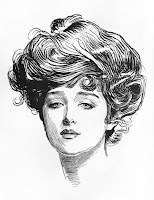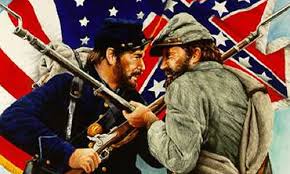 |
| Camille Clifford |
Throughout the early 19th
century the development and rise of industry in the United States was
exponential. Industrial growth was taking on new formats where human work wasn’t
nearly as involved. The moving assembly line by Henry Ford cut down work hours
and production costs and in return workers received higher wages and better
work hours. All the people who had flocked to the cities for work now had to
find ways to spend their ‘free time’. This spare time gave rise to
entertainment like sports, theater, and movies. The country work life that
consumed all time was a thing of the past. Men and women alike now had the time
to go out and explore the world around them. Women who had once been invisible now
had personas and ideals. The birth of the ‘American woman’ came to be known as
the Gibson Girl, credited to the artist Charles Dana Gibson.
 |
| Original Drawing of the Gibson Girl |
Charles Dana Gibson first began
drawing the Gibson Girl in the late 19th century. The official start
of the Gibson Girl was the publishing of his first portfolio of the iconic
woman in 1894. The Gibson Girl took shape with the help and idolization of 4
women that Charles Dana Gibson knew personally. The early model for the Gibson
girl was dance star, Evelyn Nesbit. Her upswept hair and fragile face was the ideal
model for the beginning of the Gibson Girl. She was followed by the actress
Camille Clifford and both are well known “living models” for the Gibson Girl.
But of the four women the one most direct reflections were Gibson’s wife, Irene
Langhorn. Mrs. Gibson provided the Southern Belle looks with a demure facial
expression, modest dress and regal air. She set a standard for the Gibson Girl that
Charles Dana Gibson stuck to. The Gibson Girl’s Influence all across America
was extraordinary from the comic strips was born an ideal—The ‘New Woman’.
The Gibson Girl was the “perfect
image of femininity, uniquely American.” Every woman strived to be her, the
nameless figure that was America’s woman. Everything from songs and operettas,
to clothing lines, hairstyles and wallpapers were made in the Gibson Girl
image. For every new bow that Charles Dana Gibson put in a comic strip, an identical
and real version was being worn in every lady’s hair up, down, and across the
United States. The dresses that revealed the lithe figure of the Gibson girl
could be found on every mannequin in every store. The Gibson Girl was a revolution
in the development of the ideal woman. The Gibson Girl was brought to life the
American women. Every girl strived to the one and every guy dreamed of finding
his ‘Gibson Girl’. The irony was that Charles Dana Gibson had never intended
the Gibson Girl to be anything more than a mockery of high society Americans,
but even the highest women of society adopted the ideals. One of the most
recognizable figures of the Time period was Theodore Roosevelt’s daughter, Alice
Roosevelt. If anyone was the Gibson Girl Alice Roosevelt was. Even President
Roosevelt had to agree, “I can do one of two things. I can President of the
United States, or I can control Alice. I cannot possibly do both. –Theodoore Roosevelt”
("Woman of the Year." This Fabulous Century, 1900-1910.
Vol. 1. Alexandria, VA: Time-Life, 1969. N. pag. Print.). The Gibson Girl had
created the fun loving woman that would grow into the Flappers of the 20’s and
would remain a figure of American society until the first World War.
For as much as the Gibson Girl
affected the woman and ‘who she was’, it also became a trend among the men. The
creation of a Gibson Man was eminent. As men showed up in comics with the
Gibson Girl, many of those fictional males became real life people. For every
girl that shaped herself into the Gibson Girl there was an equivalent male
figure close by waiting to woo her. Everything characterized in the comics, man
or woman, could be found walking the streets of New York or hiking up the
mountains on trails nearby. Men fantasized about being the man in the picture.
The man of the Gibson Girl can clearly be identified in the drawing in many
photos, one of which selected is Their
First Quarrel. The men of the United States were rising to meet the
expectations set forth by Charles Dana Gibson’s characters, who till this
remain nameless, which would explain why so many people were able to connect
and develop themselves without changing their identification; women especially.
 |
| Their First Quarrel |
Leisure time was the start of the
entertainment craze and the beginning of the Gibson Girl. As both of these
aspects became more plentiful, the Gibson Girl had more facets. Her ideals
manifested into activities like sports and jobs. Later drawings picture her
playing the violin, riding a bike and even selling newspapers that featured
herself. The Gibson Girl was the headway into women becoming a part of the
workforce rather than just being the invisible housewife. The influence of the
Gibson Girl spread into many areas from entertainment to commercialization. The
American woman had developed into an able bodied person of society who could
walk among men, maybe not as equals but with more influence.
 |
| Women as Jurors |
American women would not be the
multifaceted figures of the 21st century if they had never given the
jump start in the late 19th and early 20th centuries.
Without the formation and development of the Gibson Girl, many iconic ladies we
knew might have never come to light and more importantly, without the
industrial revolution and the imagination of Charles Dana Gibson.
Sources:
Wikipedia:Camille Clifford
- I used this source to make Camille Clifford had actually modeled for the Gibson Girl. I also used it as a source of way to describe the Gibson Girl
Wikipedia: Evelyn Nesbit
- I used this source to make sure Evelyn Nesbit had actually modeled for the Gibson Girl. It also gave me sources for a picture of her.
JSTOR: Charles Dana Gibson, Illustrator
- This source offered insight from another person's side of the Gibson Girl. It goes a bit more in depth into his studies in France and how he developed his style of art.
JSTOR: The Gibson Girl Goes to College
- This paper gave insight from a woman's point of view of the Gibson Girl from a later date. I used it to see different and conflicting points.
Library of Congress: Gibson Girl's America
- I used some direct quotes from this site to help show how writers in the time period pictured the Gibson Girl.
Library of Congress: The Gibson Girl Phenomenon
- I used this source to see how it influenced other cartoonists and culture surrounding the cities in the early 1900's.
Library of Congress: The Gibson Girl as The New Woman
- Described the activities that the Gibson Girl would have done. Gave me a better idea of how women would have acted when trying to copy the Gibson Girl.
Library of Congress: Creating an Ideal
- I used this as a source of ideals that were clearly described for the Gibson Girl. It gave me a clearer understanding of how people viewed her.
Library of Congress: The San Francisco Call, Sunday Magazine
- This news article was a primary source of how the Gibson Girl was actually a recognized part of society in the early 1900's.
National Museum of American Illustrators:Charles Dana Gibson, American Imagist
- This was my source on background information about Charles Dana Gibson. It gave me insight on his career and styles of drawing he might have used.








